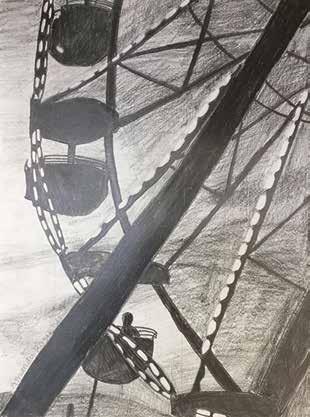
10 minute read
OUR VISION FOR EDUCATION: QUALITY TEACHERS WILL BE JUST AS CRUCIAL IN THE FUTURE
Keaton G.

Advertisement
Technology will become even more prominent; closing achievement gap is key to Minnesota’s economic future By Kirk Schneidawind, MSBA Executive Director
Editor’s Note: As the Minnesota School Boards Association celebrates its Centennial this year, we’ve asked people to write about their vision of education in 2040. This month, we start off with an essay from MSBA Executive Director Kirk Schneidawind. We’ll also have online-only essays by MSBA’s Paula O’Loughlin on education equity in 2040 and an essay by MSBA’s Greg Abbott on education funding in 2040. In future issues, we will have essays from school board members, superintendents, teachers, and students. If YOU have something to say about education in 2040, feel free to email YOUR essay to Greg Abbott at gabbott@mnmsba.org by March 31. Kirk Schneidawind
“The Jetsons.” Boomers and tail-end Gen Xers understand. A futuristic cartoon created in 1962 whose setting was a futuristic space-age kind of thing set in the year 2062. Orbit City was the model city for the future. George flew to work in his aero-car each day while Jane, Judy, Elroy, and the robot maid, Rosie, did what typical family members do — go to school, go to work, clean the house and take the dog for a walk. While the structure was like that of today’s families, they had the futuristic comforts of technological advantages that made daily life appear utopic and certainly easier than a daily routine of a Minnesotan on a snowy day in January. Albeit a cartoon, it made this youngster give some serious thought to what may be in my future: driving an aero-car to work, a robot completing my daily chores, and everything else done with a simple push of button. Perhaps a

Jasmine K.
bit idealistic; nevertheless, that cartoon did make one dream of a life of ease through technology. Will our schools in 2040 or 2060 look like Orbit City High, where students fly aboard an aero-bus to a building that may or may not resemble a school building of today? As we look forward to what our public education system looks like in the year 2040, we know that one of the key underpinnings of a strong nation is a strong system of public schools. While the question is not about hitting a reset button on our public education system, a fundamental question to ask is, “Do we envision our educational system in 2040 will look and feel like it does today?” In other words, if you could drop Minnesota’s 2020 educational system down in the year 2040, would you? Is there enough good in our current system and structure that our future students and parents would accept this? I would guess that most students and parents would say there are some things they
Valerie R.

would keep and some things would be better left in 2020. The one thing that I have learned in my years in public education is that our people who teach, administer, or school board are never satisfied with the status quo. From the elementary teacher who strives to improve math and reading proficiency by a measurable percentage, to the high school principal who aspires for a 100 percent graduation rate, to the school board and superintendent vision of a 21st century future-ready learning environment, they are unselfishly driven to do better for their students, community, and state. The inertia that comes with the “never-satisfied” mindset will not by itself create a world-class public education system in 2040; however, it does help drive and sustain change. The heart and soul of a solid educational system is teaching Hands down. We know the most influential variable on a student is a teacher who not only is gifted in the

art and science of teaching but also makes a student feel valued each day. The importance of high-quality teaching needs to be a non-negotiable, foundational element for any school and classroom structure of the future. If there is one piece that must be maintained in our schools, it is this symbiotic relationship between teachers and their students. The model of a traditional school building that we know today may not look exactly the same in 2040, but I foresee a teacher/leader still very much an important part of our educational delivery system. Whether you look back 20 years or fast forward 20 years, some of the foundational outcomes for our high school graduates will not change. Our employers and higher education institutions want graduates who can read, think critically, communicate (orally and by the written word), collaborate, show tech proficiency, and have a solid work ethic. If these skills for our graduates continue to

Amanda R. Mikayla K.
be important, and I anticipate they will, our curriculum directors and administrators will be much more focused on the development of these skills. The introduction and growth of postsecondary enrollment opportunities will continue to grow. To this point, I see greater and more robust partnerships developing between high schools and postsecondary institutions. It’s a relationship that already exists, but I foresee one that will be more seamless and collaborative. Our students, families, and employers will demand it. An additional element — that will improve an already burgeoning sector of the education market — will be the continued and growing engagement of private industry in this higher education/K-12 partnership. We have seen the growth of the academy model, career and tech programs, where the blending of public and private partnerships has resulted in more real-world, authentic learning for our students. The trifecta of a higher

education, high schools, and private industry have developed instructional models that now allow our students to apply the skills they learn in biology and ag science courses in agriculturalbased academies that blend theory with practice. We have also seen this in the health care and industrial technology sectors. This model of authentic and real-world learning is not only beneficial for the student but also helps our higher education institutions and private industry. I see this model continuing to grow and expand as we transition from an information age model that is more centered on building a career- and college-ready graduate. Technology will continue to be important As no surprise, I anticipate the use of technology will continue to be a very important element in everything our schools do, from daily operations to the delivery of instruction. “The Jetsons” proved this, right? The most recognizable difference will be the

way in which our teachers deliver instruction. As we know, technology has already bent the arc in terms of how instruction is delivered. Online offerings and virtual schools that did not exist or were just in their infancy 20 years ago are now a part of the educational landscape. A terrific example of the transformational power of how online learning continues to evolve and create tension for our traditional institutions is what has happened in the higher education space. Fifteen years ago, Arizona State University was a traditional higher education institution. Nearly all students arrived on campus to attend their required classes to earn their college degree. Today, Arizona State University is a global higher education institution where online students earn the same degree on-campus students receive. In 2012, Arizona State University’s total enrollment (all campuses) was 73,400 students. In 2018, that number is 111,000, primarily due to the expansion of their intentional efforts to
build a worldwide, online university. Just as the invention of the airplane had shrunk the world, technology has made our world smaller and eliminated district boundaries as we know them today. I don’t see online learning opportunities as the only path, but our school districts will need to be proactive in future planning. Let’s think about this. Today’s students are our digital natives 2.0. Their parents grew up with the first generation of smart phones, and this device has become an essential element of nearly every family member in every household. From the comfort of our home, car, or seat in the airport, one can access information about nearly any topic of interest through their device. This also means that lessons that have traditionally been delivered within the walls of our public school buildings can be easily be shared with students over an electronic format. This model of delivery will continue to grow and expand as technological advancements make it a more seamless and productive experience for students and staff. However, we must be mindful that access, or lack thereof, does not increase or stretch the opportunity gap for our students. Achievement gap must be addressed The biggest and most important issue that will need continued attention is our collective effort to close the achievement gap. The economic future of Minnesota depends upon it. Our state demographer has been very clear in her projections regarding the future population trends in our state. Minnesota’s population will continue to grow more diverse and at a steady pace, with our regional centers, suburban cities, and urban
areas showing the largest increases through 2035. The efforts by our public and private sectors will need to be reinforced because of the economic and societal good that will result. Investments and instructional strategies will need to be sharpened. Earlier learning opportunities need greater consideration. Most importantly, our school boards and school districts need leaders in their communities to help solve this problem. At the end of the day and as we think forward, which we ask our school boards to do as they set the vision for their districts, we must always keep the ends in mind. From a school district perspective, what do we want our high school graduates to know and be able to do? School boards will continue to play a key role in the governance of our school districts. There is nothing more fundamental or important than having a community engaged in decision-making as it relates to the education of their students and the vision for their schools. Because we work in the public school space, we understand the value and importance of our public schools. However, not everyone sees the important role and value of public schools in our communities and state. Even in 2040, our teachers, administrators, and board members must be diligent and persistent in their efforts to ensure our policymakers understand this as well. For the last two decades, we have seen how lessthan-inflationary funding and persistent and stubborn special education cross-subsidy have reduced the buying power of our school districts, which, in turn, affect student learning opportunities. No matter what the structure of our buildings looks like or how education is delivered, investment

in our schools and our students is a foundational and stabilizing element that must keep the train moving forward. With all of the outside pressures that include efforts to give the money to parents in the form of a voucher or starve our public schools into operating more efficiently, we must be loud and persistent in our continued advocacy in the role that our schools play and the importance of providing an equitable and world class education for ALL of our students. I am hopeful our state’s leaders will make the funding of our public schools their top priority.
Want to read more?
MSBA’s Greg Abbott writes about two paths education funding could take. One path follows what usually happens — we all want the best for all students but don’t want to pay for it. The other path takes foresight and courage by the Legislature and a governor to create a second Minnesota Miracle that fully funds special education, ELL programs, counseling, quality teachers, and the ability for schools to offer advanced learning. MSBA’s Paula O’Loughlin writes about what equity could look like in 2040 for schools. This aspirational declaration includes the mastery of the ABCs of educational equity: Access, Belonging, and Courage. Read these essays on our website’s Journal page at www.mnmsba.org/journal.











